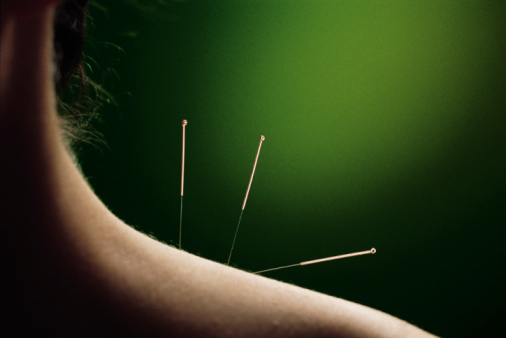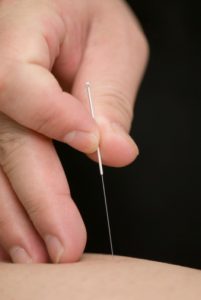 JE writes: "I am seeking advice on acupuncture to help with back pain and depression. I have researched a little on valid health websites and have found some information that acupuncture might work. From a spiritual perspective is it as dangerous as practices reiki, or is there some gray area?”
JE writes: "I am seeking advice on acupuncture to help with back pain and depression. I have researched a little on valid health websites and have found some information that acupuncture might work. From a spiritual perspective is it as dangerous as practices reiki, or is there some gray area?”When it comes to acupuncture, there’s a lot of “gray area!”
Acupuncture/acupressure is based in Traditional Chinese Medicine (TCM) and the belief that a universal life force known as chi runs through the body through 14 channels known as meridians. Practitioners believe that sickness can be caused by blockages in the flow of chi, or imbalances in two opposing "energies" known as yin and yang. In order to cure illness and other maladies, a needle or pressure is applied to any one of hundreds of points on the body known as acupoints that are positioned along the meridians and which are thought to correspond to specific organs or body systems.
Even though acupuncture/acupressure has quite a following around the world, there is virtually no scientific evidence to support its efficacy for anything other than nausea and some types of pain (and even these conclusions are not convincing). While it's true that the World Health Organization and the National Institutes of Health have come out in favor of acupuncture for some conditions, these statements have been heavily criticized for bias and reliance on poorly designed studies.
According to the Oxford-based Cochrane Collaboration, which has a global network of 10,000 health experts and a massive data base of medical research studies and clinical trials on just about every treatment you can think of, a systematic review of all the testing done on acupuncture has found no evidence that this treatment works for anything but some types of pain and nausea - and even these are not considered to be very strong conclusions.
Supporters of acupuncture like to argue that the reason acupuncture does so poorly in tests is because there is no acceptable "sham" of the procedure that can be used in blind- and double-blind tests. The problem is that the ideal "sham" must appear to be exactly like real acupuncture only the needles cannot pierce the skin - a difficult standard to reach.
 However, Professor Edzard Ernst, who led the Complementary Medicine Research Group at the University of Exeter and who has had a long history of interest in acupuncture, did indeed develop such a sham that has now been successfully used in trials. Prior to this discovery, Ernst had conducted 10 of his own clinical trials on acupuncture, wrote a book on the subject and was on the editorial board of several acupuncture journals so it's safe to say this scholar is not biased against acupuncture. His needling procedure, which he developed with Jongbae Park, a Korean Ph.D. student in his group, uses a telescopic needle that only appears to penetrate the skin and even causes a minor sensation during its supposed insertion. Although it took several years to develop and test, when the "sham" was used in trials, patients believed they were receiving real acupuncture, making these tests the highest quality acupuncture trials ever conducted.
However, Professor Edzard Ernst, who led the Complementary Medicine Research Group at the University of Exeter and who has had a long history of interest in acupuncture, did indeed develop such a sham that has now been successfully used in trials. Prior to this discovery, Ernst had conducted 10 of his own clinical trials on acupuncture, wrote a book on the subject and was on the editorial board of several acupuncture journals so it's safe to say this scholar is not biased against acupuncture. His needling procedure, which he developed with Jongbae Park, a Korean Ph.D. student in his group, uses a telescopic needle that only appears to penetrate the skin and even causes a minor sensation during its supposed insertion. Although it took several years to develop and test, when the "sham" was used in trials, patients believed they were receiving real acupuncture, making these tests the highest quality acupuncture trials ever conducted.
The results were disappointing for acupuncturists.
The tests found no convincing evidence that real acupuncture is more effective than a placebo in the treatment of even the few somewhat positive results found by the Cochrane Collaboration such as the treatment of chronic tension headaches, nausea after chemotherapy, and migraine prevention.
During the same time frame, German researchers were also conducting large and very high quality trials with their own "sham. The number of patients in these trials ranged from 200 to 1,000 people. Initial conclusions from these mega trials found that acupuncture was no more effective than sham acupuncture in treating the four ailments which were the subject of the tests - migraines, tension headaches, chronic low back pain and knee osteoarthritis.
Even though many people believe acupuncture works, this isn't because "it's all in their minds." Science knows that pricking one’s skin with a needle causes the release of pain-suppressing endorphins and other chemicals in the body that lend relief to the sufferer. But this has nothing to do with acupuncture’s so-called acupoints. We can pierce the body anywhere with a pin and produce the same chemical reaction. In fact, as this blog explains, a recent study found that acupuncturists don’t even agree on where the acupoints are located on the body!
As for a spiritual component to acupuncture, this definitely exists. Acupuncture is a form of traditional Chinese medicine which has as its goal the restoration of harmony to each organ system in the body in order to resolve not only physical but emotional and spiritual imbalances as well.
I personally spoke with a former acupuncturist who practiced the Traditional Chinese Medicine form of acupuncture who said the procedure is routinely used to rid the body of bad spirits, much like our rite of exorcism. She even spoke about the special clothing the acupuncturist wears during these procedures to avoid contamination, and how they open a window or door in order to let the spirits out of the room.
This blog will explain the spiritual dangers in more detail.
If you’re looking for a proven non-pharmaceutical alternative to acupuncture, this blog lists various treatments that have endured rigorous scientific scrutiny and have been proven effective.
Needless to say, there are numerous dangers inherent in allowing New Age and/or Eastern medicine practitioners to exercise control over your spiritual well-being, either directly or indirectly.
© All Rights Reserved, Living His Life Abundantly®/Women of Grace® http://www.womenofgrace.com
